Introduction
Imagine if world political leaders managed their countries like they managed BBQs. Can you picture the meticulous precision of Japanese Prime Minister Yoshihide Suga tending to his robatayaki grill, or the fiery passion of Indian Prime Minister Narendra Modi stoking a tandoor? While it might sound far-fetched, there’s a lot we can learn from global BBQ traditions about managing the flames, smoke, and heat of our own backyard grills.
By exploring diverse BBQ techniques from around the world, we can not only enhance the flavor of our meals but also become true masters of the BBQ. Buckle up as we embark on a global BBQ bonanza and learn to harness the fire with a blend of humor and culinary wisdom!
Section 1: The Fiery Fundamentals of Fire Management
Fire management in the BBQ world might sound like a scene from an action movie where the hero has to control a blazing inferno. But in reality, it involves understanding the delicate balance of heat, airflow, and patience. Let’s compare these elements to some over-dramatized ‘international fire incidents’ for a touch of humor.
Infographic: Different Types of Grills and Their International Counterparts
- American Smoker: Think of the classic Texan approach – low and slow with lots of smoke, similar to navigating a slow-moving legislative process.
- Indian Tandoor: An intense, high-heat clay oven that cooks food quickly, akin to a political leader making quick and decisive changes.
- Japanese Robatayaki: A grill with precise heat control, much like a diplomat’s careful negotiation tactics.
- Argentinean Asado: A method that involves perfect heat distribution, reminiscent of coalition governments balancing multiple interests.
Section 2: Best Practices for Fire Management from Around the Globe
Let’s dive into traditional fire management techniques from different regions and see what we can learn from these global BBQ masters.
Low and Slow: American Southern BBQ
The American Southern BBQ tradition emphasizes “low and slow” cooking, where meats are smoked over a low flame for several hours. This method allows the meat to absorb smoky flavors and become incredibly tender.
Intense Heat: Indian Tandoor
In India, tandoor cooking involves an earthen oven that reaches extremely high temperatures. The intense heat sears the exterior of the meat, locking in juices and creating a delicious char.
Precision: Japanese Robatayaki
Japanese robatayaki cooking is all about precision. By controlling the heat carefully and cooking each item to perfection, Japanese chefs ensure even cooking and optimal flavor.
Section 3: How International Techniques Can Improve Your Fire Management
Now, let’s take these global techniques and see how we can adapt them for our backyard BBQs.
Adopting Japanese Robatayaki
For precise heat control and even cooking, try the Japanese robatayaki technique:
- Use a grill with adjustable racks or a raised cooking surface to control the distance between the food and the heat source.
- Monitor the heat carefully and adjust as needed to ensure even cooking.
- Marinate meats and vegetables for added flavor before grilling.
American ‘Low and Slow’ Technique
Incorporate the American ‘low and slow’ approach by:
- Using a smoker or a grill with a smoker box.
- Choosing cuts of meat that benefit from long cooking times, like brisket or pork shoulder.
- Keeping the temperature low (around 225°F) and maintaining consistent smoke.
Step-by-Step Guide:
To make these techniques super easy to follow, here’s a step-by-step guide presented as a secret diplomatic dossier:
- Step 1: Choose your grill and understand its quirks. Are you working with a high-heat tandoor-like setup, or a slow-smoking American-style grill?
- Step 2: Prep your meat and marinades. Embrace international flavors; think soy sauce for Japanese styles or aromatic spices for Indian tandoor.
- Step 3: Manage your heat source. Use adjustable racks for precision or low, consistent heat for smoking.
- Step 4: Monitor and adjust. Use a thermometer if needed to ensure even cooking.
- Step 5: Enjoy your worldly BBQ feast and take notes for future improvements.
Section 4: Fire Management Tips for Beginners Inspired by International Methods
If you’re new to the BBQ scene, don’t fret! Here are some beginner-friendly tips inspired by international practices:
Southeast Asian Bamboo Skewers
Bamboo skewers are excellent for grilling bite-sized pieces of meat and vegetables. They are especially good for beginners because they allow for easy handling and even cooking.
Mastering the Argentinean Asado
The Argentinean asado method focuses on perfect heat distribution. Start by:
- Building a consistent bed of coals spread evenly across the grill.
- Using a metal grate that evenly distributes heat.
- Regularly checking and adjusting the position of your food for even cooking.
Parodic Do’s and Don’ts List
Here’s a fun list of do’s and don’ts to avoid international BBQ blunders:
- Do: Experiment with flavors and techniques from around the world. Your taste buds will thank you.
- Don’t: Try to grill everything at the highest heat. You’ll end up with a diplomatic disaster on your hands!
- Do: Use a thermometer for precise cooking, much like a careful diplomat gauges reactions.
- Don’t: Forget to marinate or season your meats. A bland BBQ is like a bland speech – it just doesn’t cut it.
Section 5: BBQ Diplomacy – Hosting an Internationally Inspired BBQ Party
Why not showcase your newfound international BBQ techniques by hosting an internationally inspired BBQ party? Here are some tips to make it a cultural extravaganza:
Ideas for Themed Foods
- Tandoor-Style Cooking Station: Set up a high-heat grill for tandoori meats and naan.
- Caribbean Vibe: Play some salsa music and offer jerk chicken or grilled plantains.
- Japanese Touch: Include robatayaki grilled veggies and skewers, and perhaps some sake.
Decorations and Music
Set the stage with themed decorations and music:
- String up lights and colorful banners reflecting the countries represented.
- Create a playlist featuring music from around the world to enhance the ambiance.
- Encourage guests to come dressed in attire that represents different cultures for added fun.
Conclusion
Let’s recap the key takeaways from our ‘international summit on BBQ.’ Fire management is an art that can benefit greatly from a global perspective. By embracing diverse culinary techniques, we not only expand our BBQ repertoire but also create more flavorful, memorable meals. Whether you’re adopting the precise heat control of robatayaki or the rich flavors of a tandoor, incorporating these methods can elevate your grilling game.
Encouragement: Don’t be afraid to experiment and share your experiences. Consider opening a ‘BBQ embassy’ in your backyard, where friends and family can gather to enjoy a worldly feast.
Call to Action
We’d love to hear from you! Comment below with your own fire management tips and BBQ traditions. Have you tried any of these international techniques? Share your story and maybe even a few photos of your BBQ creations.
For more advanced BBQ techniques and to explore cultural cuisines further, keep an eye on our blog for upcoming posts. Happy grilling!
Sidebar/Additional Features:
Quiz: “What International BBQ Style Are You?”
Take our light-hearted quiz to find out which BBQ style matches your personality! From Japanese precision to American largesse, discover your BBQ alter ego.
Video Tutorial: “World Tour of BBQ Techniques”
Check out our quick, engaging video clips that showcase practical tips from international BBQ masters. Learn step-by-step methods to perfect your grilling skills.


